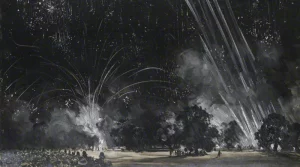Munsell's Colour System
For centuries, artists, designers, and scientists have sought to understand and categorise colour in a way that rises above personal perception. Among the most influential figures in this pursuit of colour was Albert Henry Munsell (1858-1918), an American painter and colour theorist whose systematic approach to colour classification continues to shape our understanding of colour theory today.
The Science Behind Munsell’s Colour System
Unlike earlier colour theorists such as Johann Wolfgang von Goethe (1749—1832), who explored the emotional and psychological impact of colour, Munsell took a more rigorous and scientific approach to his work. Building off the circular colour model of his predecessor, Sir Isaac Newton (1643—1727), which arranged spectral colours in a wheel, he sought to create a standardised system that would allow for precise communication of colour across disciplines. In 1905, he published A Colour Notation, in which he established a three-dimensional model of colour based on three core attributes:
- Hue: The type of colour
- Value: The lightness or darkness of a colour
- Chroma: The purity or intensity of a colour
This approach allowed for an objective description of any colour, which was a significant advancement over the subjective and often inconsistent colour wheel models used by earlier theorists.
Munsell’s colour system introduced the concept of equal perceptual spacing, meaning that the steps between colours in his system were based on human visual perception rather than arbitrary mathematical divisions. This principle made his system more intuitive for users and useful across multiple fields.
Munsell’s Impact on Art, Design, and Science
The influence of Munsell’s Colour System extends far beyond his lifetime. In the early twentieth century, his work was widely adopted in academic settings, influencing notable artists such as Wassily Kandinsky (1866—1944), who explored the relationships between colour, form, and emotion in modern art. Many artists and designers found Munsell’s method invaluable for achieving harmony in their compositions.
His systematic approach to colour harmony followed that of his predecessor, Michel Eugène Chevreul (1786—1889), whose focus on colour balance in textiles influenced artistic and scientific approaches to colour. His structured methodology was also embraced as a way to teach colour mixing and theory more effectively in the classroom.
Beyond the art world, Munsell’s Colour System became a cornerstone in soil classification. This was particularly important in the agricultural, geological and environmental sciences, where a lack of standardisation in the nineteenth century led to inconsistent terminology across the disciplines. Munsell’s early system provided a structured approach that eliminated ambiguity and allowed for accurate comparisons of soil colour worldwide. The Munsell Soil Colour Charts were officially published in 1949 and have become an essential tool in soil colour classification. They are still used today to standardise soil analysis worldwide.
Munsell's Enduring Legacy in Art, Science, and Colour Theory
Munsell’s contribution to colour theory was not just theoretical; it was practical and implementable. His work provided a common language for colour that is still widely used today, ensuring consistency in how we perceive and communicate colour in the modern world.
In an era where digital technology plays an increasing role in colour theory, his structured approach remains more relevant than ever. Whether you are mixing paints, selecting textiles for an interior space, or working in scientific research, an understanding of Munsell’s methodology provides a strong foundation for working with colour accurately and effectively. His work continues to be an essential resource for artists and scientists alike, offering a scientific yet accessible way to engage with the world of colour.
This edition from Art Meets Science combines Munsell’s seminal A Colour Notation with all fifteen full-colour plates from Atlas of the Munsell Color System, an introduction by Munsell, and an essay on colour by Bonnie E. Snow. An essential colour manual for those studying colour theory or with an interest in colour application, colour behaviours, and the history of colour theory.
Read more on colour theory
Discover the art meets science collection
-
 Art/Color TheorySelect options This product has multiple variants. The options may be chosen on the product page
Art/Color TheorySelect options This product has multiple variants. The options may be chosen on the product pageEmily Vanderpoel’s Color Problems
£7.99 – £34.99Price range: £7.99 through £34.99 -
 Geometry/MathematicsSelect options This product has multiple variants. The options may be chosen on the product page
Geometry/MathematicsSelect options This product has multiple variants. The options may be chosen on the product pageOliver Byrne’s Elements of Euclid
£9.99 – £33.99Price range: £9.99 through £33.99 -
 Art/Color TheorySelect options This product has multiple variants. The options may be chosen on the product page
Art/Color TheorySelect options This product has multiple variants. The options may be chosen on the product pageWerner’s Nomenclature of Colours
£9.99 – £22.99Price range: £9.99 through £22.99
-
 Art/Astronomy/ScienceSelect options This product has multiple variants. The options may be chosen on the product page
Art/Astronomy/ScienceSelect options This product has multiple variants. The options may be chosen on the product pageUrania’s Star Charts
£7.99 – £29.99Price range: £7.99 through £29.99 -
 Animals/Butterflies & Moths/NatureSelect options This product has multiple variants. The options may be chosen on the product page
Animals/Butterflies & Moths/NatureSelect options This product has multiple variants. The options may be chosen on the product pageMaria Sibylla Merian’s Metamorphosis
£9.99 – £34.99Price range: £9.99 through £34.99 -
 Artists' Books/Individual Photographers/PhotographySelect options This product has multiple variants. The options may be chosen on the product page
Artists' Books/Individual Photographers/PhotographySelect options This product has multiple variants. The options may be chosen on the product pageAnna Atkins’ Cyanotypes of British and Foreign Ferns
£9.99 – £24.99Price range: £9.99 through £24.99












